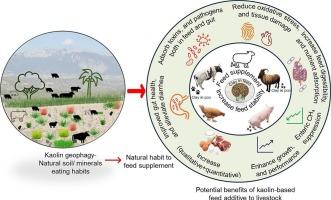Kaolin clay-based diets for managing livestock's health and methane emission problem
IF 5.8
2区 地球科学
Q2 CHEMISTRY, PHYSICAL
引用次数: 0
Abstract
Increased livestock production is essential to meet the rising food and agri-services demand. However, livestock emit 70–95 % of agricultural methane (CH4), a potent greenhouse gas, through their enteric fermentation. While various feed additives have been proposed to address CH4 emissions and livestock production, this review highlights the potential of kaolin clays to serve these benefits by leveraging animals’ natural consumption habits. Over 136 non-human animal species are actively engaged in geophagy (earth-eating), and most of them prefer kaolin-rich soils. These animals routinely consume such soils as a source of essential minerals, and to manage gut parasites/pathogens, mycotoxins, gastrointestinal disorders, diarrhea, and acidosis. By learning from these feeding habits and their health benefits, raw and modified kaolin minerals can be used as feed ingredients in livestock’s regular diets. The unique morphology (e.g., platy kaolinite and hollow tubular halloysite) and surface properties (e.g., easy dispersion in solution to develop high Al3+ and polyhydroxy-Al ions) of kaolin can reduce enteric CH4 emissions by intervening in its related biochemical reactions, while enhancing animal production. At the same time, these added clay particles are excreted through the feces. Unprocessed kaolin may often contain iron as an impurity, which is typically considered an economic burden due to additional processing requirements. However, this kaolin can be beneficial as a feed ingredient as it can enhance enteric CH4 inhibition as well as alleviate iron deficiencies in livestock. This review will also discuss possible modifications of kaolin prior to adding it as a feed supplement for better and more sustainable outcomes in managing CH4 emissions, and animal health problems.

用于管理牲畜健康和甲烷排放问题的高岭土饲粮
增加畜牧业生产对于满足日益增长的粮食和农业服务需求至关重要。然而,家畜通过肠道发酵排放了70 - 95%的农业甲烷(CH4),这是一种强有力的温室气体。虽然已经提出了各种饲料添加剂来解决甲烷排放和牲畜生产问题,但本综述强调了高岭土通过利用动物的自然消费习惯来实现这些好处的潜力。超过136种非人类动物积极参与食土活动,其中大多数动物更喜欢富含高岭土的土壤。这些动物通常将这些土壤作为必需矿物质的来源,并用于控制肠道寄生虫/病原体、真菌毒素、胃肠道疾病、腹泻和酸中毒。通过了解这些饲养习惯及其对健康的益处,可以将未经加工和改性的高岭土矿物质用作牲畜日常饲料中的饲料成分。高岭土独特的形态(如板状高岭土和空心管状高岭土)和表面特性(如易在溶液中分散形成高Al3+和多羟基al离子)可通过干预其相关生化反应减少肠道CH4排放,同时提高动物产量。同时,这些添加的粘土颗粒通过粪便排出体外。未加工的高岭土通常含有铁作为杂质,由于额外的加工要求,通常被认为是经济负担。然而,这种高岭土作为饲料成分是有益的,因为它可以增强肠道CH4抑制作用,并缓解牲畜的铁缺乏症。本综述还将讨论在将高岭土添加为饲料添加剂之前对其进行可能的改性,以便在管理CH4排放和动物健康问题方面取得更好和更可持续的结果。
本文章由计算机程序翻译,如有差异,请以英文原文为准。
求助全文
约1分钟内获得全文
求助全文
来源期刊

Applied Clay Science
地学-矿物学
CiteScore
10.30
自引率
10.70%
发文量
289
审稿时长
39 days
期刊介绍:
Applied Clay Science aims to be an international journal attracting high quality scientific papers on clays and clay minerals, including research papers, reviews, and technical notes. The journal covers typical subjects of Fundamental and Applied Clay Science such as:
• Synthesis and purification
• Structural, crystallographic and mineralogical properties of clays and clay minerals
• Thermal properties of clays and clay minerals
• Physico-chemical properties including i) surface and interface properties; ii) thermodynamic properties; iii) mechanical properties
• Interaction with water, with polar and apolar molecules
• Colloidal properties and rheology
• Adsorption, Intercalation, Ionic exchange
• Genesis and deposits of clay minerals
• Geology and geochemistry of clays
• Modification of clays and clay minerals properties by thermal and physical treatments
• Modification by chemical treatments with organic and inorganic molecules(organoclays, pillared clays)
• Modification by biological microorganisms. etc...
 求助内容:
求助内容: 应助结果提醒方式:
应助结果提醒方式:


